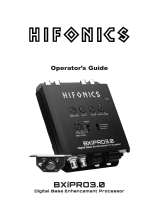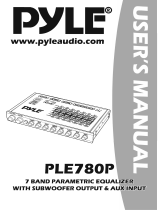Hifonics HFEQ-2 Quick Start Guide Owner's manual
- Category
- Speaker sets
- Type
- Owner's manual
This manual is also suitable for

Operator’s Guide
HFEQ-2

Thank you for purchasing the HIFONICS HFEQ-2 4-Band Equalizer/
two-way crossover. This unit has both a pre-amp equalizer and
crossover to provide the multi-speaker system of your vehicle with
improved sound performance. Please read the entire manual to
ensure proper connections and application.
CAUTION
Always consider consulting a professional audio installer
before installing any audio components. Be careful and take
your time. Do not let wires make contact with metal edges or
hot engine components.
Features
• TWO COLOR (RED/BLUE) CONTROL KNOB LEDS
• 2-CHANNEL UNBALANCED LINE INPUT
• DESIGNATED SUBWOOFER UNBALANCED OUTPUT
• SUBWOOFER X-OVER FREQUENCY CONTROL
• INPUT LEVEL CONTROL ADJUSTMENT
• MONO/STEREO SELECTION
• FADER CONTROL
• HALF DIN CHASSIS SIZE
• MOUNTING HARDWARE (INCLUDED)
• MID BASS/SUB BASS/MID RANGE/TREBLE CONTROL

Mounting and Hardware
Prior to mounting, connect the wires
to ensure proper operation.
MOUNTING
1. Select the desired mounting location, either under the dash or
in the dash. Make sure that there is adequate depth for the HFEQ-2.
2. Use the mounting brackets and hardware provided. Make sure
there is proper clearance for the mounting bracket screws when
attaching under the dash. Use caution to ensure there are no wiring
harnesses behind the dash panel (where the mounting
screws are fastened).
3. Route the power, ground, and remote wires away from moving
parts to prevent pinching or shortened wires.
WIRING
1. Power Wire: The power wire should connect to a constant or
switched +12 volt source with a (1 Amp) provided in-line fuse. We
recommend that you use the radio constant or switch +12 volt source.
2.Gound Wire: Connect the ground wire to a clean chassis ground
point. Be sure to remove all paint and primer to expose clean metal.
Use a ring terminal and lock or star washer to secure the ground wire.
3. Remote Wire: The remote wire should be connected to the source
until remote or antenna wire that provides +12 volts when the
source unit is “on” and 0 volts when the source unit is turned “off.”

14
13
12
10
9
11
6
7
8
Volume Control: The audio level (volume) can be increased or decreased with this
illuminated VOLUME control knob.
Subwoofer Control: The Subwoofer output level is controlled by the SUB
illuminated knob.
Fader Control: Allows to control the front and rear output levels.
Input Selection: Allows to select input channel 1, 2 (AUX).
LED Selection: Allows to change the control knob back light illumination color from
red to blue.
Sub Bass Control: This control allows to adjust the sub bass volume at 45Hz to
increase or decrease.
Mid Bass Control: This control allows to adjust the mid bass volume at 120Hz to
increase or decrease.
Mid Range Control: This control allows to adjust the mid bass volume at 2.2KHz to
increase or decrease.
Treble Control: This control allows to adjust the treble volume at 12KHz to
increase or decrease.
Power Connectors: This is the input jack that supplies power, ground and remote.
The 12+ Volt Terminal Connects to either constant +12 volts or to an accessory
switched +12 volt source. The radio power wire is preferred source. (This is a
fused power wire).
The Ground Terminal Connect to chassis ground.
The Remote Terminal Connect to the source unit remote or antenna output wire
that provides +12 volts when the source unit is “on” and 0 volts when the source
unit is turned “off.”
Front Outputs: This is high pass output to be connected to the amplier(s) inputs
for front speakers.
Rear Outputs: This is high pass output to be connected to the amplier(s) inputs
for rear speakers.
Subwoofer Outputs: The subwoofer left & right are low pass outputs when
crossover is used and are connected to the subwoofer amplifer(s) inputs.
Input 2 (AUX): Channle 2 input from the source unit (radio/CD player) have L & R
unbalanced inputs which are directly routed to the internal EQ and passed though
to the Channel 2 outputs. Each input can be choosen independently by the input
selector switch.
Functions & Operations
1
4
2
3
5

16
18
15
17
Input 1 (AUX): Channel 1 input from the source unit (radio/CD player) have L & R
unbalanced inputs which are directly routed to the internal EQ and passed though
to the Channel 1 outputs. Each input can be choosen independently by the input
selector switch.
Front/Rear Subwoofer Frequency Switch: This switch allows you to choose
between three different frequency settings or allow full-range (in the “Off” position)
for the subwoofer or front/rear output.
Stereo/Mono Switch: This allows you to select stereo or mono for the subwoofer
output.
Input Level (Gain) Control: This input level control can be adjusted to match the
source unit line-level sensitivity.
Functions & Operations
101112131415
16
17
18
1 2 3 4 5 6 7 8 9

Diagnostics & Trouble Shooting
The key to nding the problem in a troubled sound system is to isolate parts of that
system in a logical fashion to track down the fault and correct the issue.
The diagnostic system will not shut down the crossover or the amplier(s), although
the amplier(s) own protection circuitry may shut the amplier(s) down, should a fault
status occur. You will need to consult the owners manual for that particular amplier.
4-Channel Source Unit Setup
4 CHANNEL OUTPUT
AMPLIFIER
SUB OUTPUT
AMPLIFIER
SOURCE
UNIT
PHONE OR
MP3 PLAYER
CHASSIS GND
IGNITION (REM)
DC+12V

1) Check that level controls have been set up properly.
2) Make sure that the battery voltage, as measured at the
amplier(s) and crossover +12 volt and ground terminals,
is 11 volts or more.
3) Check all +12 volt and ground connections.
1) Insure that the voltage to the unit does not exceed 15 volts.
2) A short on the main +12 volt cable from the battery to the vehicle
chassis will cause the main fuse to blow.
3) If the HFEQ-2 is blowing fuses continually with only +12 volt,
ground and remote leads connected, the unit may be faulty.
1) High levels of white noise usually occur when level controls are
turned up too high – reduce the levels until the noise is no
longer present.
2) Another problem that can cause excessive hiss, is a noisy
head unit – unplug the crossover input RCA’s, and if the hiss level
reduces, the source unit is at fault.
1) Check all fuses.
2) Check all connections.
3) Measure the +12 volt and remote turn on voltages at the
amplier(s) and crossover terminals. If these are nonexistent or
low, take voltage measurements at fuse holders, distribution
blocks, the head unit’s +12 volt, and remote leads to localize
the problem.
Low Output
Power
Fuses
Blowing
Hiss, or
White Noise
Fuses
Blowing
1) This problem could be caused by radiation pickup of RCA cables
that are too close to a fuel pump or a distributor.
2) Check that the head unit ground is connected straight to the
vehicle chassis and does not use factory wiring for ground.
3) Try to supply the head unit with a clean +12 volt supply directly
from the battery +, instead of using a supply from the in-dash
wiring/fusebox.
This type of noise can be more difcult to pinpoint, but is usually
caused by some kind of instability, causing oscillations in the
system.
1) Check all connections, (especially for good grounds).
2) Make sure that no speaker leads are shorting to exposed metal
on the vehicle chassis.
3) RCA cable are notorious for their problematic nature, so check
that these are good, especially the shield connections.
Ticking or
Whine that
changes
with engine
RPM
Constant
Whine
The inside of an automobile is a very hostile electrical environment. The
multitude of electrical systems, such as the ignition system, alternator, fuel
pumps, and air conditioners, create radiated electrical elds, as well as
noise on the +12 volt supply and ground. To try and eliminate this noise,
run a wire from the radio ground wire to the ground input on the equalizer.
Electrical
Interference

Specications
OUTPUT CHANNELS (LEFT/RIGHT) FRONT/REAR/SUBWOOFER
INPUT CHANNELS (LEFT/RIGHT) INPUT 1 / INPUT 2
INPUT RANGE OF GAIN CONTROL (dB) >40
MAXIMUM INPUT VOLTAGE (V) >10
INPUT IMPEDANCE (K-OHMS) >20
MAXIMUM OUTPUT VOLTAGE >9
VOLUME GAIN (dB) >40
-3dB LOW PASS FREQUENCY (Hz) 50>80>120
-3dB HIGH PASS FREQUENCY (Hz) 80>120>200
LOW PASS/HIGH PASS SLOPE/OCTAVE 12
EQUALIZATION FREQUENCIES (Hz) 45>120>2200>12000
EQUALIZATION CYT OR BOOST (dB) 18
DISTORTION AT 1kHz - 1V (%) .01
CHANNEL SEPARATION AT 1kHz (dB) >80
SIGNAL TO NOISE RATIO (dB) >100
FREQUENCY RESPONSE (Hz) (-1dB) 10-50K
Autotek products are designed and engineered in the USA by
www.maxxsonics.com
HF HFEQ-2 QSG 01 - rev1
WARRANTY
Maxxsonics USA Inc. warrants this product, to the original consumer purchaser, to be free from
defects in material and workmanship for a period of one (1) year from the date of purchase.
Maxxsonics USA Inc. will, at it’s discretion, repair or replace defective products during the warranty
period. Components that prove to be defective in materials and workmanship under proper installation
use must be returned to the original authorized Maxxsonics USA Inc. retailer from where it was
purchased. A photocopy of the original receipt must accompany the product being returned. The
costs associated with removal, re-installation, and freight are not the responsibility of Maxxsonics
USA Inc. This warranty is limited to defective parts and specically excludes any incidental or
consequential damages connected therewith. To view the full warranty, please visit the website.
Visit Hifonics.com
-
 1
1
-
 2
2
-
 3
3
-
 4
4
-
 5
5
-
 6
6
-
 7
7
-
 8
8
Hifonics HFEQ-2 Quick Start Guide Owner's manual
- Category
- Speaker sets
- Type
- Owner's manual
- This manual is also suitable for
Ask a question and I''ll find the answer in the document
Finding information in a document is now easier with AI
Related papers
-
Hifonics Mt. Olympus Odin/Cyclops Owner's manual
-
Hifonics Cyclops 3K Owner's manual
-
Hifonics HFEQ Owner's manual
-
HIFONIC BXiPro3.0 Owner's manual
-
Hifonics ZXI Zeus User manual
-
Hifonics HFi User manual
-
Hifonics HS2500.1D User manual
-
Hifonics ZRX Zeus User manual
-
Hifonics BRE2500.1D User manual
-
Hifonics Sampson Owner's manual
Other documents
-
Crunch CREQ7B User guide
-
Autotek 7004B Four-Band Equalizer/Two way Crossover User manual
-
 HIFONIC BXiPRO3 Digital Bass Enhancement Processor User guide
HIFONIC BXiPRO3 Digital Bass Enhancement Processor User guide
-
Autotek AT1200 User manual
-
 PYLE Audio Mobile Audio System User manual
PYLE Audio Mobile Audio System User manual
-
Crunch GTR Owner's manual
-
 Maxxsonics GPV1100.2 User manual
Maxxsonics GPV1100.2 User manual
-
Crunch PowerZone PZA Owner's manual
-
Crunch PRZA Owner's manual
-
Crunch PowerZone Owner's manual










